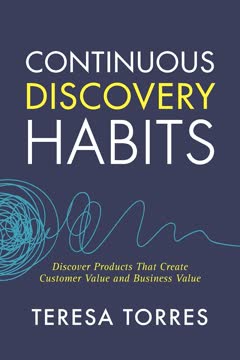가지 주요 요점
1. 게임화: 게임 메커니즘을 활용한 사용자 참여 유도
게임 사고방식과 게임 메커니즘을 통해 사용자를 참여시키고 문제를 해결하는 과정.
게임화 정의. 게임화는 게임 디자인 요소와 원칙을 비게임 맥락에 적용하는 것을 의미합니다. 이는 우리의 본능적인 게임 사랑을 활용하여 일상적인 작업을 더 흥미롭고 동기부여가 되도록 만듭니다. 포인트, 배지, 리더보드, 도전 과제와 같은 요소를 통합함으로써 게임화는 교육, 피트니스, 생산성, 고객 충성도 프로그램 등 다양한 분야에서 사용자 경험을 변혁할 수 있습니다.
주요 이점:
- 사용자 참여 및 유지 증가
- 동기부여 및 행동 변화 강화
- 학습 및 기술 개발 향상
- 고객 충성도 및 브랜드 친밀도 증가
- 사용자 행동에 대한 데이터 기반 통찰력
게임화는 성취, 지위, 사회적 연결에 대한 인간의 근본적인 욕구를 활용합니다. 효과적으로 구현되면, 사용자가 지속적으로 참여하고, 개선하고, 경험을 공유하도록 동기부여되는 선순환을 창출할 수 있습니다.
2. 플레이어 동기 이해: 효과적인 게임화의 핵심
그 실질적인 보상이 무엇이든 간에, 그 가치를 공개해야 합니다 (또는 가장 충성도 높은 고객에게 그 가치가 본질적으로 알려져 있어야 합니다). 결과적으로, 플레이어는 상호작용의 가치를 정확하게 평가하는 경향이 있습니다.
플레이어 유형. 다양한 플레이어 동기를 이해하는 것은 효과적인 게임화 시스템을 설계하는 데 중요합니다. 리처드 바틀의 플레이어 유형은 네 가지 주요 유형을 식별합니다: 성취자 (성취에 의해 동기부여됨), 탐험가 (발견에 의해 동기부여됨), 사교가 (상호작용을 추구함), 킬러 (경쟁적이고 지배적임). 개인은 여러 유형의 특성을 보일 수 있지만, 이러한 핵심 동기를 인식하면 다양한 사용자 선호에 맞춘 경험을 설계할 수 있습니다.
내적 동기 vs. 외적 동기:
- 내적: 내부 동기 (예: 즐거움, 개인 성장)
- 외적: 외부 보상 (예: 포인트, 배지, 상)
내적 동기와 외적 동기의 균형을 맞추는 것이 중요합니다. 외부 보상은 참여를 촉진할 수 있지만, 내적 동기를 키우는 것이 더 지속 가능하고 장기적인 참여를 이끕니다. 디자이너는 사용자의 내부 동기와 일치하는 시스템을 만들면서 의미 있는 외부 인식과 보상을 제공하는 것을 목표로 해야 합니다.
3. 핵심 게임 메커니즘: 포인트, 레벨, 리더보드, 배지
포인트는 플레이어 간에 공유되든, 디자이너와 플레이어 간에 공유되든 상관없이 중요합니다.
게임화의 구성 요소. 이러한 기본 요소는 대부분의 게임화 시스템의 중추를 형성합니다:
- 포인트: 진행 상황을 정량화하고 즉각적인 피드백 제공
- 레벨: 진행을 구조화하고 성취감을 제공
- 리더보드: 경쟁과 사회적 비교 촉진
- 배지: 특정 성취와 이정표를 인정
각 메커니즘은 고유한 심리적 목적을 제공합니다. 포인트는 지속적인 피드백과 진행 감각을 제공합니다. 레벨은 명확한 목표와 구조화된 마스터리 경로를 제공합니다. 리더보드는 우리의 경쟁 본능과 사회적 지위를 활용합니다. 배지는 성취를 수집하고 표시하려는 욕구를 충족시킵니다.
이 요소를 설계할 때 고려해야 할 사항:
- 투명성: 사용자가 포인트를 얻고 진행하는 방법을 이해하도록 보장
- 균형: 도전감을 제공하면서도 달성 가능한 목표 설정
- 의미: 보상을 사용자나 시스템에 진정으로 유익한 행동과 연결
- 다양성: 인식과 진행을 얻는 다양한 방법 제공
4. 온보딩 및 사회적 참여: 매력적인 사용자 여정 설계
초보자에게 마스터 수준의 도전을 주어서는 안 됩니다. 다른 수준에 맞는 도전 과제가 적절하며 근본적으로 더 성공적입니다.
첫인상이 중요합니다. 잘 설계된 온보딩 프로세스는 사용자 유지와 장기적인 참여에 중요합니다. 주요 원칙은 다음과 같습니다:
- 점진적 복잡성: 기능과 메커니즘을 점진적으로 소개
- 초기 성공: 자신감을 키우기 위해 빠르고 달성 가능한 성공 제공
- 명확한 안내: 직관적인 튜토리얼과 상황별 도움 제공
- 개인화: 사용자 선호나 목표에 따라 경험 맞춤화
사회적 참여 루프는 참여의 선순환을 만듭니다:
- 동기부여 감정 (예: 연결 욕구)
- 사회적 행동 촉구 (예: 친구 초대)
- 플레이어 재참여 (예: 알림)
- 가시적 진행/보상 (예: 새로운 기능 잠금 해제)
사회적 역학을 활용함으로써, 게임화 시스템은 커뮤니티 내에서의 연결과 지위에 대한 본능적인 욕구를 활용할 수 있습니다. 이는 참여를 증가시킬 뿐만 아니라 사용자 주도의 바이럴 루프를 통해 유기적인 성장을 촉진합니다.
5. 맞춤화 및 보상: 게임화된 경험의 개인화
우리는 상대적으로 쉽게 제품이나 서비스에 게임화된 "아이싱"을 뿌릴 수 있지만, 기본 케이크가 맛있지 않으면 대부분의 사용자는 두 번째 한 입을 원하지 않을 것입니다.
개인화의 힘. 사용자가 경험을 맞춤화할 수 있도록 하면 투자와 소유감이 증가합니다. 이는 다음을 포함할 수 있습니다:
- 아바타 생성 및 맞춤화
- 개인 목표나 도전 과제 선택
- 선호하는 보상 유형 선택
- 인터페이스 요소나 테마 맞춤화
그러나 "선택의 폭정"을 경계해야 합니다. 너무 많은 옵션은 사용자를 압도할 수 있습니다. 의미 있는 맞춤화를 제공하되 결정 마비를 피하십시오.
보상 전략:
- 가상 상품: 인식된 가치가 있는 디지털 아이템 (예: 아바타 액세서리)
- 접근: 독점 콘텐츠나 기능
- 권력: 시스템 내에서의 능력이나 영향력 증가
- 현실 세계의 혜택: 앱 내 성취와 연계된 실질적인 혜택
효과적인 보상 시스템은 즉각적인 만족과 장기적인 목표를 균형 있게 제공합니다. 예측 가능한 보상과 놀라운 보상을 혼합하여 관심을 유지하십시오. 항상 보상이 애플리케이션의 맥락 내에서 의미가 있고 사용자 동기와 일치하도록 하십시오.
6. 도전과 성취의 균형: 레벨 디자인의 예술
게임 디자인에서 레벨 난이도는 선형적이지 않습니다. 즉, 레벨 1에 도달하는 데 100포인트, 레벨 2에 200포인트, 레벨 3에 300포인트가 필요한 것이 아닙니다. 대신 난이도는 곡선형으로 증가합니다.
점진적 도전. 잘 설계된 레벨 시스템은 지속적인 진행 감각을 제공하면서 최적의 도전 수준을 유지합니다. 주요 고려 사항:
- 학습 곡선: 쉽게 시작하고 점진적으로 복잡성 증가
- 기술 기반 진행: 사용자 능력에 맞춘 도전 과제
- 의미 있는 이정표: 정기적인 간격으로 명확하고 달성 가능한 목표 설정
- 가변 난이도: "쉬운 승리"와 도전 과제를 모두 포함
플로우 상태. 사용자를 "플로우"라는 심리적 상태에 유지하는 것을 목표로 합니다, 여기서 도전과 기술이 균형을 이룹니다:
- 너무 쉬움 → 지루함
- 너무 어려움 → 불안
- 적절함 → 플로우 (몰입, 집중, 즐거움)
사용자 데이터를 정기적으로 분석하여 난이도 곡선을 미세 조정하고 대부분의 사용자가 좌절감 없이 꾸준히 진행할 수 있도록 하십시오.
7. 분석 및 반복: 게임화 시스템의 지속적인 개선
애자일 디자인은 출시 전에 최소 기능 제품을 찾습니다—디자이너와 타겟 소비자가 지금 필요로 하는 것—나중에 변경할 수 있다는 것을 알고 있습니다.
데이터 기반 디자인. 강력한 분석을 구현하는 것은 사용자 행동을 이해하고 게임화 시스템을 최적화하는 데 중요합니다. 추적할 주요 지표:
- 참여: 일일/월간 활성 사용자, 세션 길이, 유지율
- 진행: 레벨 분포, 도전 과제/퀘스트 완료율
- 사회적: 초대율, 바이럴 계수, 사회적 공유 빈도
- 수익화: 전환율, 사용자당 평균 수익 (해당되는 경우)
반복적 개선:
- 핵심 기능으로 출시 (최소 기능 제품)
- 사용자 행동 및 문제점에 대한 데이터 수집
- 트렌드 분석 및 개선 영역 식별
- 변경 사항 및 새로운 기능 구현
- 이 과정을 지속적으로 반복
실제 사용에 기반하여 시스템을 조정할 준비를 하십시오. 이론적으로 좋은 것이 실제 사용자에게는 공감되지 않을 수 있습니다. 애자일 마인드를 받아들이고, 지속적으로 피드백을 수집하고 데이터에 기반한 개선을 통해 게임화된 경험을 최적화하십시오.
8. 실제 응용: 성공적인 게임화 사례 연구
나이키 플러스는 플레이어를 게임에 자연스럽게 끌어들이고 다시 돌아오고 싶게 만듭니다—따라서 더 나은 러너가 되려는 목표를 진전시킵니다.
성공에서 배우기. 실제 사례를 검토하면 효과적인 게임화 전략에 대한 귀중한 통찰력을 제공합니다:
-
나이키+: 게임화된 피트니스 추적
-
사회적 도전 과제와 유명인 격려
-
시각적 진행 맵핑 및 성취 축하
-
현실 세계 목표와의 통합 (예: 마라톤 훈련)
-
듀오링고: 언어 학습 앱
-
구조화된 진행을 위한 스킬 트리
-
일일 연속성과 시간 제한 도전 과제
-
즉각적인 피드백과 소규모 레슨
-
스택 오버플로우: 개발자를 위한 Q&A 플랫폼
-
양질의 기여에 대한 명성 포인트와 배지
-
명성 수준에 따른 특권
-
게임화된 관리 및 커뮤니티 관리
성공적인 구현에서 얻은 주요 교훈:
- 게임 메커니즘을 핵심 사용자 동기와 제품 목표에 맞추기
- 사용자를 장기적으로 참여시키는 의미 있는 진행 시스템 만들기
- 사회적 역학을 활용하여 유지율과 바이럴 성장을 증가시키기
- 게임화를 통해 원하는 행동과 기술 개발 강화
- 사용자 피드백과 데이터 분석을 기반으로 지속적으로 반복
이러한 예제를 연구하고 특정 맥락에 맞게 전략을 조정함으로써, 사용자에게 더 매력적이고 효과적인 게임화된 경험을 제공할 수 있습니다.
마지막 업데이트 날짜:
FAQ
What's "Gamification by Design" about?
- Overview: "Gamification by Design" by Gabe Zichermann explores how game mechanics can be implemented in web and mobile applications to enhance user engagement and solve business problems.
- Core Concept: The book introduces the concept of gamification, which involves using game-thinking and game mechanics to engage users and solve problems.
- Practical Guide: It serves as a practical guide for marketers, product designers, and strategists to understand and apply gamification in their projects.
- Case Studies and Examples: The book includes case studies and examples to illustrate successful gamification strategies in various industries.
Why should I read "Gamification by Design"?
- Understanding Gamification: It provides a comprehensive understanding of gamification and its potential to transform user engagement and business strategies.
- Practical Application: The book offers practical advice and techniques for implementing gamification in real-world scenarios.
- Expert Insights: Written by a leading expert in the field, it includes insights and lessons from successful gamification projects.
- Broad Audience: It is suitable for marketers, product designers, developers, and anyone interested in leveraging game mechanics for business success.
What are the key takeaways of "Gamification by Design"?
- Game Mechanics: Understanding and applying game mechanics like points, badges, levels, and leaderboards can significantly enhance user engagement.
- Player Motivation: Identifying and leveraging player motivations, such as mastery, social interaction, and achievement, is crucial for successful gamification.
- Design Principles: The book emphasizes the importance of designing for engagement, using frameworks like MDA (Mechanics, Dynamics, Aesthetics).
- Case Studies: Real-world examples demonstrate how gamification can be effectively implemented across different industries and applications.
How does "Gamification by Design" define gamification?
- Definition: Gamification is defined as the process of using game-thinking and game mechanics to engage users and solve problems.
- Flexible Framework: This framework is powerful and flexible, applicable to any problem that can be addressed by influencing human motivation and behavior.
- Broader Context: It unites concepts like serious games, advergaming, and games-for-change into a cohesive worldview informed by behavioral psychology.
- Practical Application: The book provides a practical approach to applying this definition in business and product design.
What are the foundational concepts in "Gamification by Design"?
- Fun Quotient: The book emphasizes that everything has the potential to be fun, and fun should be a primary goal in design.
- Player Motivation: Understanding powerful human motivators, such as mastery and social interaction, is key to designing engaging experiences.
- Game Mechanics: Core mechanics like points, badges, levels, and leaderboards are essential tools for creating engaging systems.
- SAPS Model: The SAPS (Status, Access, Power, Stuff) model is introduced as a system of rewards, with status being the most desired.
How does "Gamification by Design" address player motivation?
- Intrinsic vs. Extrinsic: The book discusses the balance between intrinsic and extrinsic motivation, emphasizing the importance of aligning them.
- Player Types: It categorizes players into types like achievers, socializers, explorers, and killers, each with different motivations.
- Progression to Mastery: The book outlines a progression from novice to visionary, highlighting the importance of designing for different mastery levels.
- Motivational Techniques: Techniques like feedback, reinforcement, and social engagement loops are explored to enhance motivation.
What are the key game mechanics discussed in "Gamification by Design"?
- Points and Levels: Points are used to track and reward player actions, while levels indicate progress and status.
- Badges and Leaderboards: Badges serve as visual rewards for achievements, and leaderboards provide social comparison and competition.
- Challenges and Quests: These provide direction and goals for players, enhancing engagement and motivation.
- Customization and Feedback: Customization allows players to personalize their experience, and feedback provides real-time progress updates.
How does "Gamification by Design" suggest implementing gamification?
- MDA Framework: The book recommends using the MDA (Mechanics, Dynamics, Aesthetics) framework to design engaging experiences.
- Onboarding: It emphasizes the importance of a smooth onboarding process to introduce players to the system and encourage initial engagement.
- Iterative Design: The book advocates for an agile, iterative approach to design, allowing for continuous improvement and tuning.
- Case Studies: Real-world examples, like Nike Plus and Foursquare, illustrate successful implementation strategies.
What are some case studies highlighted in "Gamification by Design"?
- Nike Plus: This case study shows how gamification can make fitness fun by using social support, feedback, and challenges to motivate runners.
- Foursquare: The book discusses how Foursquare successfully used badges and leaderboards to solve the "empty bar problem" and engage users.
- Health Month: This example demonstrates how gamification can motivate people to improve their health through a structured, social game.
- Quora vs. Yahoo! Answers: The book compares these platforms to highlight different approaches to gamifying questions and answers.
What are the potential pitfalls of gamification according to "Gamification by Design"?
- Overjustification: Replacing intrinsic motivation with extrinsic rewards can sometimes undermine long-term engagement.
- Badgenfreude: An overabundance of meaningless badges can lead to disengagement and devalue the reward system.
- Gaming the System: Players may attempt to exploit the system, so it's important to design with safeguards and iterate based on player behavior.
- Misalignment: Poorly aligned game mechanics and player motivations can result in ineffective or counterproductive outcomes.
How does "Gamification by Design" address the legal and ethical considerations of gamification?
- Legal Issues: The book highlights the importance of understanding legal and regulatory issues, especially concerning virtual currencies and rewards.
- Terms of Service: It advises creating clear terms of service and applying them consistently to protect the integrity of the system.
- Policing the System: The book suggests employing admin or sysop positions to monitor and control player behavior and transactions.
- Ethical Design: Designers are encouraged to consider the ethical implications of their gamification strategies and prioritize player well-being.
What are the best quotes from "Gamification by Design" and what do they mean?
- "Fun Is Job #1": This quote emphasizes the importance of making experiences enjoyable, as fun is a key driver of engagement and motivation.
- "The House Always Wins": This highlights the need for well-designed systems where the designer maintains control and ensures the system's success.
- "Be the Sherpa": This metaphor encourages designers to guide players on their journey to mastery, providing support and structure along the way.
- "Gamification is about to change everything": This statement reflects the transformative potential of gamification in various industries and applications.
리뷰
Gamification by Design은 다양한 평가를 받았다. 독자들은 실용적인 접근 방식과 게이미피케이션 개념의 도입을 높이 평가했지만, 많은 이들이 책이 시대에 뒤떨어지고 깊이가 부족하다고 느꼈다. 일부는 책의 예시와 체크리스트를 칭찬했으나, 다른 이들은 상업적인 초점과 게임 메커니즘에 대한 얕은 다룸을 비판했다. 이 책은 초보자에게는 좋은 출발점으로 여겨졌지만, 경험이 많은 독자들에게는 새로운 정보가 거의 없었다. 여러 리뷰어들은 책의 자기 홍보적인 측면과 시대에 뒤떨어진 참고 자료를 단점으로 지적했다. 전반적으로, 이 책은 게이미피케이션 기법에 대한 기본적인 개요를 제공하지만 장기적인 가치는 제한적이라는 평가를 받았다.
Similar Books













